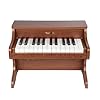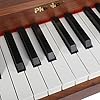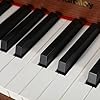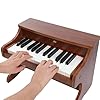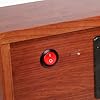Table of Contents
Mastering the Left Hand on Piano
The journey to mastering the left hand in piano playing is crucial for achieving balance and harmonic depth in music. For many pianists, especially right-handed individuals, developing dexterity and independence in the left hand can be a challenging but rewarding endeavor. This introduction will explore the foundational techniques and critical practices essential for enhancing left-hand performance, aiming to help musicians fully utilize their potential and bring more expressive capabilities to their performances.
Understanding the Role of the Left Hand in Piano Playing
The left hand in piano playing often supports the rhythm and harmony of a piece, providing a foundation that enhances the melodies played by the right hand. Mastering left-hand techniques is crucial for achieving a balanced and expressive performance. It involves a combination of strength, flexibility, and independence from the right hand. In this introduction, we will explore essential techniques to enhance the proficiency and musicality of the left hand.
Best Choice Products 61-Key Electronic Keyboard Piano Portable Electric Keyboard Complete Beginner Set w/LED Screen, Stand, Bench, Headphones - Black
20% OffDonner 61 Key Keyboard Piano, Electric Piano Keyboard Kit with 249 Voices, 249 Rhythms - Includes Piano Stand, Stool, Microphone, Gift for Beginners, Black (DEK-610S)
33% OffPLAMILOY Kids Piano 25-Key, Toddler Musical Keyboard Toy, Portable Wooden Electronic Keyboard for 3 Ages+, Educational Learning Gift for Boys & Girls
$89.99 (as of December 13, 2025 11:40 GMT -08:00 - More infoProduct prices and availability are accurate as of the date/time indicated and are subject to change. Any price and availability information displayed on [relevant Amazon Site(s), as applicable] at the time of purchase will apply to the purchase of this product.)The 23 Greatest Solo Piano Works
12% OffBass Note Mastery
The foundation of left-hand technique lies in the effective use of bass notes. These notes serve as the rhythmic and harmonic bedrock for various musical styles. Achieving mastery over bass notes involves developing a strong sense of timing and the ability to produce clear, articulate tones. Practitioners need to focus on exercises that enhance finger strength and accuracy, ensuring that each note firmly supports the musical structure.
Chords and Progressions
Chords and progressions are pivotal in defining the harmonic landscape of a composition. The left hand must be adept at switching between complex chord structures smoothly and efficiently. This requires not only a theoretical understanding of harmonic functions but also practical skills in voicing and finger placement. Players should practice various chord shapes, transitions, and inversions to develop a versatile and responsive left hand.
Arpeggio Technique
Arpeggios are a fundamental aspect of left-hand technique, allowing for the creation of flowing and expansive musical lines. Mastery of arpeggios enhances a pianist’s ability to articulate and embellish harmonies. To excel, pianists must work on their speed, fluidity, and control through dedicated exercises focusing on evenness and synchronization between the hands.
Counterpoint and Independence
Developing independence between the hands is essential for performing more complex pieces where the left hand plays a counter-melodic role. This technique requires the player to think of each hand as an autonomous entity, capable of complex rhythms and melodies. Exercises designed to promote hand separation and contrapuntal thinking are essential for this aspect of left-hand technique.
Piano Adventures - Level 2A Lesson Book
$6.99 (as of December 13, 2025 13:37 GMT -08:00 - More infoProduct prices and availability are accurate as of the date/time indicated and are subject to change. Any price and availability information displayed on [relevant Amazon Site(s), as applicable] at the time of purchase will apply to the purchase of this product.)The Piano Proficiency Exam Review Book
$14.57 (as of December 13, 2025 13:50 GMT -08:00 - More infoProduct prices and availability are accurate as of the date/time indicated and are subject to change. Any price and availability information displayed on [relevant Amazon Site(s), as applicable] at the time of purchase will apply to the purchase of this product.)P71 Digital Piano Review and Guide
$0.00 (as of December 13, 2025 13:27 GMT -08:00 - More infoProduct prices and availability are accurate as of the date/time indicated and are subject to change. Any price and availability information displayed on [relevant Amazon Site(s), as applicable] at the time of purchase will apply to the purchase of this product.)Final Exam Review (Piano Collection)
$1.29 (as of December 13, 2025 13:50 GMT -08:00 - More infoProduct prices and availability are accurate as of the date/time indicated and are subject to change. Any price and availability information displayed on [relevant Amazon Site(s), as applicable] at the time of purchase will apply to the purchase of this product.)Dynamic Control and Articulation
The left hand is not merely a support tool but also a primary vehicle for expressing dynamics and articulation. Effective control over these elements allows the pianist to convey emotions and narrative through music. Pianists should focus on developing the ability to vary touch and intensity, practicing techniques such as legato, staccato, and the use of the sustain pedal for adding depth to the sound.
1. Scales and Arpeggios
Practicing scales and arpeggios is fundamental for developing dexterity in the left hand. Start with simple major and minor scales, playing slowly to ensure accuracy and gradually increasing the tempo. For arpeggios, focus on maintaining a smooth, flowing motion without tensing up your fingers.
2. Hanon Exercises
Hanon exercises, particularly those from “The Virtuoso Pianist”, are excellent for building strength and agility. These exercises are designed to improve finger independence and control, which are crucial for left-hand technique. Start with the first exercises, making sure each note is played evenly and gradually increasing the speed as you become more comfortable.
3. Czerny Exercises
Carl Czerny’s studies, such as the “School of Velocity,” feature numerous pieces emphasizing the left hand. These compositions not only enhance technical ability but also improve musicality. Focus on exercises that challenge the left hand with intricate rhythms or rapid passages.
4. Octave Practices
Playing octaves can significantly enhance the strength and reach of your left hand. Start with simple octave scales, ensuring each note is clear and using minimal tension. As you progress, incorporate dynamic changes and varying rhythms to develop more control and endurance.
5. Chord Inversions
Practice various chord inversions to improve your left hand’s ability to move smoothly across the keyboard. Work on playing these chords in different progressions, paying attention to the transitions between them to ensure fluid movement and accurate finger placement.
6. Left-Hand Dominant Pieces
Learning pieces written specifically for the left hand can greatly assist in its development. Start with simpler compositions and gradually tackle more complex works, such as those by Scriabin or Godowsky, which offer advanced challenges tailored specifically for the left hand.
7. Contrapuntal Exercises
Engage with contrapuntal exercises such as those found in Bach’s ‘Inventions’ or ‘Sinfonias’. These works not only help in left-hand development but also enhance overall hand coordination, as they require both hands to operate independently yet harmoniously.
8. Rhythm and Timing Challenges
Incorporate exercises that focus on varying rhythmic patterns. For instance, practice playing different rhythms with the left hand while keeping a steady beat with the right, or vice versa. This improves the left hand’s rhythmic accuracy and precision.
9. Dynamic Control Exercises
Work on playing softly with the left hand while playing loudly with the right hand, and then switch dynamics. These types of exercises improve the dynamic control and can help highlight the melodic lines in more complex pieces.
10. Finger Independence Drills
Practice exercises that isolate each finger, such as pressing one finger down while lifting others. These drills boost the independence and strength of each finger, reducing over-reliance on more dominant fingers.
Playing Bass Lines with Confidence
Mastering bass lines on the piano involves a strong sense of rhythm and an understanding of the underlying harmony. Begin by isolating the left hand to focus solely on the bass components before integrating both hands. Practice with a metronome to develop a consistent tempo, and gradually increase the speed as you gain confidence.
Start with simple patterns and progress to more complex syncopations and rhythms. Use different musical genres to broaden your skill set, as each genre has its unique bass line characteristics. Record your practices to monitor your progress and identify areas for improvement.
Playing Chords with Confidence
To effectively play chords, the left hand must be fluid and adaptable to various chord shapes and progressions. Begin by learning the fundamental chord structures, such as triads and seventh chords, in all keys. Practice progression like the 12-bar blues to gain a practical understanding of chord movement in a musical context.
Enhancing your chord playing entails working on hand positioning and finger independence, ensuring each note of the chord sounds clean and clear. Employ exercises that challenge you to switch between chords swiftly and accurately. Engage in ear training exercises to better recognize chord qualities and progressions, thereby speeding up your reactive time during performances.
Syncing Both Hands for Harmony
Creating harmony between the left and right hands on the piano is essential for cohesive and expressive performance. This process involves several key techniques and practices that ensure fluid coordination and musical synergy between both hands.
1. Start Slowly
When beginning to sync both hands, it’s crucial to start at a slow tempo. This allows you to focus on the accuracy of notes and timing without being overwhelmed. Gradually increase the speed as you gain more confidence and control.
2. Use a Metronome
A metronome is a valuable tool for developing synchronization. It provides a consistent beat that helps manage timing between the left and right hands. Begin with a slow metronome setting and gradually increase the tempo as your synchronization improves.
3. Simplify Complex Sections
In complex musical passages, simplify the sections by breaking them down into smaller, manageable parts. Practice each hand separately then slowly layer them together, focusing on maintaining rhythm and harmony. This technique helps build muscle memory and coordination.
4. Hands Together, Hands Separate Practice
Practice difficult passages with each hand separately before trying them together. This approach allows you to understand and master the nuances and roles of each hand. Once each hand is confident independently, combine them to practice cohesiveness.
5. Visualize the Keyboard
Visualization techniques can greatly enhance hand coordination. Away from the piano, visualize playing the keys and syncing both hands. This mental practice can reinforce physical coordination when you do practice on the instrument.
6. Record and Review
Recording your practice sessions can be incredibly helpful. It allows you to listen back and identify areas where the synchronization between hands can be improved. This self-review promotes a better understanding of your progress and areas that require more effort.
7. Regular Interval Training
Integrating interval training into your practice routine can boost synchronization. Practice scales, arpeggios, and chord progressions regularly, as these exercises reinforce hand independence and coordination valuable for playing more complex pieces harmoniously.
8. Master the Art of Pedaling
The use of the sustain pedal can blur or enhance the harmony between hands. Learning when and how to use the pedal appropriately is crucial for achieving a clearer and more expressive performance through proper synchronization.
9. Find a Technique Coach
Working with a piano teacher or a technique coach can provide personalized feedback and structured guidance. This tailored help can be crucial in mastering the intricate balance and timing needed between both hands.
Common Left-Hand Challenges on Piano
One of the most common challenges for piano players is developing independence between the left and right hands. Since most people have a dominant right hand, the left hand can often lag in dexterity and coordination.
Overcoming the Challenge: To improve independence, practice is essential. Start with slow, simple exercises focusing on contrasting rhythms or movements between hands. Gradually increase complexity as comfort and skill levels improve. Using a metronome can help maintain consistent tempo and aid rhythm training.
The left hand is frequently less agile than the right, tending to be less precise in dynamic control and articulation.
Overcoming the Challenge: Implement exercises specifically aimed at building strength and agility in the left hand. Scales, arpeggios, and Hanon exercises can be particularly effective. Focus on playing these exercises with clear articulation and dynamic variations. Practice regularly, focusing specifically on the passages that challenge the left hand.
Many piano pieces, particularly in classical and jazz genres, involve intricate bass patterns that require significant left-hand dexterity and rhythm understanding.
Overcoming the Challenge: Break down complex patterns into smaller, manageable segments. Practice these segments slowly, ensuring accuracy with notes and rhythms. Gradually combine these segments and increase speed as proficiency develops. It’s also useful to practice with a metronome to keep the rhythm steady and accurate.
The left hand often handles the underlying harmony, providing support to the melodic phrases played by the right hand. Ensuring that the harmony complements rather than overshadows the melody can be challenging.
Overcoming the Challenge: Focus on dynamics and touch. Practice playing the chords or accompanying figures with a softer touch than the melody. Exercises that focus on dynamic control, such as playing crescendos and decrescendos with only the left hand, can be greatly beneficial. Always be mindful of the balance and aim to enhance the expressive capabilities of both hands.
For many, reading bass clef notes is less intuitive than treble clef, leading to slower sight-reading and hesitations in playing.
Overcoming the Challenge: Regular practice in reading and playing from bass clef is crucial. Start with simple pieces or exercises focused on the bass clef and gradually increase the complexity as you become more comfortable. Utilizing sight-reading software or apps can also provide additional practice and help build confidence.
Conclusion
Mastering the left hand on piano is an essential skill that can significantly enhance your overall playing ability. By focusing on regular practice, proper technique, and independent coordination, you can develop a balanced and expressive performance. Remember, patience and persistence are key; with dedication, your left hand will become a powerful and collaborative force in your piano playing journey.














